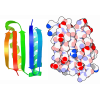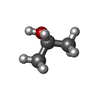[English] 日本語
 Yorodumi
Yorodumi- PDB-1bnd: STRUCTURE OF THE BRAIN-DERIVED NEUROTROPHIC FACTOR(SLASH)NEUROTRO... -
+ Open data
Open data
- Basic information
Basic information
| Entry | Database: PDB / ID: 1bnd | ||||||
|---|---|---|---|---|---|---|---|
| Title | STRUCTURE OF THE BRAIN-DERIVED NEUROTROPHIC FACTOR(SLASH)NEUROTROPHIN 3 HETERODIMER | ||||||
 Components Components |
| ||||||
 Keywords Keywords | COMPLEX (GROWTH FACTOR/GROWTH FACTOR) / NEUROTROPHIN / COMPLEX (GROWTH FACTOR-GROWTH FACTOR) COMPLEX | ||||||
| Function / homology |  Function and homology information Function and homology informationpositive regulation of brain-derived neurotrophic factor receptor signaling pathway / NTF3 activates NTRK3 signaling / BDNF activates NTRK2 (TRKB) signaling / NTF3 activates NTRK2 (TRKB) signaling / Activated NTRK3 signals through PLCG1 / brain-derived neurotrophic factor receptor signaling pathway / Activated NTRK2 signals through PLCG1 / Signaling by NTRK3 (TRKC) / nerve growth factor receptor binding / MECP2 regulates transcription of neuronal ligands ...positive regulation of brain-derived neurotrophic factor receptor signaling pathway / NTF3 activates NTRK3 signaling / BDNF activates NTRK2 (TRKB) signaling / NTF3 activates NTRK2 (TRKB) signaling / Activated NTRK3 signals through PLCG1 / brain-derived neurotrophic factor receptor signaling pathway / Activated NTRK2 signals through PLCG1 / Signaling by NTRK3 (TRKC) / nerve growth factor receptor binding / MECP2 regulates transcription of neuronal ligands / : / negative regulation of myotube differentiation / Activated NTRK2 signals through CDK5 / nerve growth factor signaling pathway / NTRK2 activates RAC1 / regulation of protein localization to cell surface / nerve development / collateral sprouting / Activated NTRK2 signals through FYN / positive regulation of collateral sprouting / induction of positive chemotaxis / Activated NTRK2 signals through PI3K / Activated NTRK3 signals through PI3K / positive regulation of synapse assembly / chemoattractant activity / negative regulation of apoptotic signaling pathway / positive regulation of receptor internalization / Activated NTRK3 signals through RAS / Activated NTRK2 signals through RAS / Activated NTRK2 signals through FRS2 and FRS3 / synapse assembly / neuron projection morphogenesis / NPAS4 regulates expression of target genes / axon guidance / cell surface receptor protein tyrosine kinase signaling pathway / growth factor activity / positive regulation of neuron projection development / modulation of chemical synaptic transmission / Constitutive Signaling by Aberrant PI3K in Cancer / synaptic vesicle / nervous system development / PIP3 activates AKT signaling / cell-cell signaling / PI5P, PP2A and IER3 Regulate PI3K/AKT Signaling / regulation of apoptotic process / negative regulation of neuron apoptotic process / positive regulation of phosphatidylinositol 3-kinase/protein kinase B signal transduction / positive regulation of MAPK cascade / positive regulation of cell migration / endoplasmic reticulum lumen / signaling receptor binding / axon / positive regulation of cell population proliferation / dendrite / perinuclear region of cytoplasm / signal transduction / extracellular space / extracellular region / cytoplasm Similarity search - Function | ||||||
| Biological species |  Homo sapiens (human) Homo sapiens (human) | ||||||
| Method |  X-RAY DIFFRACTION / Resolution: 2.3 Å X-RAY DIFFRACTION / Resolution: 2.3 Å | ||||||
 Authors Authors | Robinson, R.C. / Radziejewski, C. / Stuart, D.I. / Jones, E.Y. | ||||||
 Citation Citation |  Journal: Biochemistry / Year: 1995 Journal: Biochemistry / Year: 1995Title: Structure of the brain-derived neurotrophic factor/neurotrophin 3 heterodimer. Authors: Robinson, R.C. / Radziejewski, C. / Stuart, D.I. / Jones, E.Y. #1:  Journal: Biochemistry / Year: 1993 Journal: Biochemistry / Year: 1993Title: Heterodimers of the Neurotrophic Factors: Formation, Isolation, and Differential Stability Authors: Radziejewski, C. / Robinson, R.C. | ||||||
| History |
|
- Structure visualization
Structure visualization
| Structure viewer | Molecule:  Molmil Molmil Jmol/JSmol Jmol/JSmol |
|---|
- Downloads & links
Downloads & links
- Download
Download
| PDBx/mmCIF format |  1bnd.cif.gz 1bnd.cif.gz | 60.7 KB | Display |  PDBx/mmCIF format PDBx/mmCIF format |
|---|---|---|---|---|
| PDB format |  pdb1bnd.ent.gz pdb1bnd.ent.gz | 44.4 KB | Display |  PDB format PDB format |
| PDBx/mmJSON format |  1bnd.json.gz 1bnd.json.gz | Tree view |  PDBx/mmJSON format PDBx/mmJSON format | |
| Others |  Other downloads Other downloads |
-Validation report
| Summary document |  1bnd_validation.pdf.gz 1bnd_validation.pdf.gz | 387.4 KB | Display |  wwPDB validaton report wwPDB validaton report |
|---|---|---|---|---|
| Full document |  1bnd_full_validation.pdf.gz 1bnd_full_validation.pdf.gz | 393.8 KB | Display | |
| Data in XML |  1bnd_validation.xml.gz 1bnd_validation.xml.gz | 6.8 KB | Display | |
| Data in CIF |  1bnd_validation.cif.gz 1bnd_validation.cif.gz | 9.7 KB | Display | |
| Arichive directory |  https://data.pdbj.org/pub/pdb/validation_reports/bn/1bnd https://data.pdbj.org/pub/pdb/validation_reports/bn/1bnd ftp://data.pdbj.org/pub/pdb/validation_reports/bn/1bnd ftp://data.pdbj.org/pub/pdb/validation_reports/bn/1bnd | HTTPS FTP |
-Related structure data
| Similar structure data |
|---|
- Links
Links
- Assembly
Assembly
| Deposited unit | 
| ||||||||
|---|---|---|---|---|---|---|---|---|---|
| 1 | 
| ||||||||
| 2 |
| ||||||||
| Unit cell |
| ||||||||
| Atom site foot note | 1: CIS PROLINE - PRO B 47 |
- Components
Components
| #1: Protein | Mass: 13534.590 Da / Num. of mol.: 1 Source method: isolated from a genetically manipulated source Source: (gene. exp.)  Homo sapiens (human) / Description: SUPPLIED BY REGENERON PHARM.; / Organ: BRAIN / Production host: Homo sapiens (human) / Description: SUPPLIED BY REGENERON PHARM.; / Organ: BRAIN / Production host:  |
|---|---|
| #2: Protein | Mass: 13656.437 Da / Num. of mol.: 1 Source method: isolated from a genetically manipulated source Details: HETERODIMER / Source: (gene. exp.)  Homo sapiens (human) / Description: SUPPLIED BY REGENERON PHARM.; / Organ: BRAIN / Production host: Homo sapiens (human) / Description: SUPPLIED BY REGENERON PHARM.; / Organ: BRAIN / Production host:  |
| #3: Chemical | ChemComp-IPA / |
| #4: Water | ChemComp-HOH / |
| Has protein modification | Y |
-Experimental details
-Experiment
| Experiment | Method:  X-RAY DIFFRACTION X-RAY DIFFRACTION |
|---|
- Sample preparation
Sample preparation
| Crystal | Density Matthews: 2.44 Å3/Da / Density % sol: 49.64 % | |||||||||||||||||||||||||
|---|---|---|---|---|---|---|---|---|---|---|---|---|---|---|---|---|---|---|---|---|---|---|---|---|---|---|
| Crystal | *PLUS Density % sol: 50 % | |||||||||||||||||||||||||
| Crystal grow | *PLUS Temperature: 18 ℃ / pH: 5.6 / Method: vapor diffusion, sitting drop | |||||||||||||||||||||||||
| Components of the solutions | *PLUS
|
-Data collection
| Diffraction source | Wavelength: 1.54 |
|---|---|
| Detector | Type: MARRESEARCH / Detector: IMAGE PLATE / Date: Jan 4, 1994 |
| Radiation | Monochromatic (M) / Laue (L): M / Scattering type: x-ray |
| Radiation wavelength | Wavelength: 1.54 Å / Relative weight: 1 |
| Reflection | Num. obs: 11771 / % possible obs: 93.4 % / Rmerge(I) obs: 0.082 |
| Reflection | *PLUS Highest resolution: 2.3 Å / Lowest resolution: 20 Å / Num. obs: 11691 / Rmerge(I) obs: 0.082 |
| Reflection shell | *PLUS Highest resolution: 2.3 Å / Lowest resolution: 2.36 Å / % possible obs: 85.6 % / Num. unique obs: 1455 / Rmerge(I) obs: 0.15 |
- Processing
Processing
| Software |
| ||||||||||||||||||||||||||||||||||||||||||||||||||||||||||||||||||||||||||||||||
|---|---|---|---|---|---|---|---|---|---|---|---|---|---|---|---|---|---|---|---|---|---|---|---|---|---|---|---|---|---|---|---|---|---|---|---|---|---|---|---|---|---|---|---|---|---|---|---|---|---|---|---|---|---|---|---|---|---|---|---|---|---|---|---|---|---|---|---|---|---|---|---|---|---|---|---|---|---|---|---|---|---|
| Refinement | Resolution: 2.3→20 Å / σ(F): 0 /
| ||||||||||||||||||||||||||||||||||||||||||||||||||||||||||||||||||||||||||||||||
| Displacement parameters | Biso mean: 45.8 Å2 | ||||||||||||||||||||||||||||||||||||||||||||||||||||||||||||||||||||||||||||||||
| Refinement step | Cycle: LAST / Resolution: 2.3→20 Å
| ||||||||||||||||||||||||||||||||||||||||||||||||||||||||||||||||||||||||||||||||
| Refine LS restraints |
| ||||||||||||||||||||||||||||||||||||||||||||||||||||||||||||||||||||||||||||||||
| Software | *PLUS Name:  X-PLOR / Classification: refinement X-PLOR / Classification: refinement | ||||||||||||||||||||||||||||||||||||||||||||||||||||||||||||||||||||||||||||||||
| Refinement | *PLUS | ||||||||||||||||||||||||||||||||||||||||||||||||||||||||||||||||||||||||||||||||
| Solvent computation | *PLUS | ||||||||||||||||||||||||||||||||||||||||||||||||||||||||||||||||||||||||||||||||
| Displacement parameters | *PLUS | ||||||||||||||||||||||||||||||||||||||||||||||||||||||||||||||||||||||||||||||||
| Refine LS restraints | *PLUS
| ||||||||||||||||||||||||||||||||||||||||||||||||||||||||||||||||||||||||||||||||
| LS refinement shell | *PLUS Highest resolution: 2.3 Å / Lowest resolution: 2.36 Å / Total num. of bins used: 9 / Num. reflection obs: 1455 / Rfactor all: 0.324 |
 Movie
Movie Controller
Controller


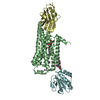
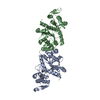


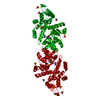



 PDBj
PDBj






